Some Movers and Shakers of Early Victoria
Evergreen Cemetery
Information prepared for Evergreen Cemetery Tour by Henry Wolff, Jr. Oct. 5, 2002, Victoria, Texas. Many thanks to Henry Wolff, Jr. for allowing us to use this script and to Billye Jackson for the photographs.
Dr. J.B.P. January (1811-1890)
Dr. James Belvarde Pope January was born on May 27, 1811, in Maysville, Kentucky. After attending Transylvania University, he moved to Mississippi where in December of 1835, he enlisted in the Texas Army. In January, 1836, he came to Texas with the "Red Rovers" organized by Dr. John Shackelford in Alabama. Illness forced him back to New Orleans but he returned in April. While stationed at Camp Independence (present Jackson County), he attended Albert Sidney Johnston after the famous general was severely wounded in a duel with Felix Huston. He later fought in the western campaign against the Comanches, returned to Jackson County and was elected to the 8th Congress of the Republic. He also served in the Mexican War and during the Civil War was captured in Louisiana. He would live out his life as a physician in Victoria until his death on April 10, 1890.

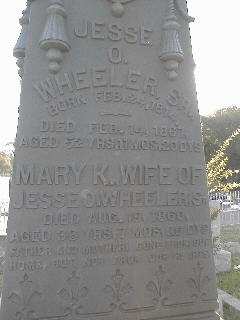
Jesse Obediah Wheeler
(1814-1867)
Jesse Obediah Wheeler was one of Victoria's early movers and shakers. Born in Rutland, Vermont, on Feb. 24, 1814, little is known of his life before he moved to Victoria in 1840 and opened a mercantile store. He participated in the fight against the Comanche Indians at Plum Creek following the raid on Linnville. He dealt in cotton, real estate, livestock, and managed toll bridges on the Guadalupe River. He served at various times as city alderman and mayor and helped establish Victoria's first property tax. He also started river commerce on the Guadalupe with the steamboat William Penn and was instrumental in the establishment of the San Antonio and Mexican Gulf Railroad. At one time, he was the wealthiest man in Victoria. While in France for his health, he died on Feb. 14, 1867, and his body was returned to Victoria labeled as a marble block to circumvent superstitions of the sailors.
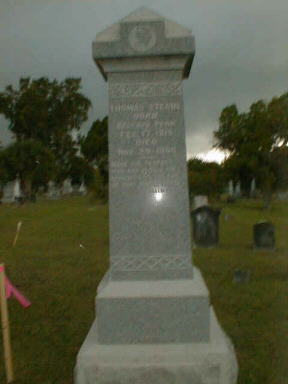
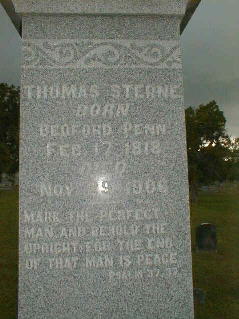
Thomas Sterne
(1818-1906)
Born in Bedford, Pennsylvania in February, 1818, Thomas Sterne began practicing the printer's trade when he was only 12 years old. He drifted south as a journeyman printer on the Lewisville City Gazette, and worked in Arkansas for a time before starting the first newspaper in Van Buren, the Arkansas Intelligencer. He and John D. Logan would later publish the Western Frontier Whig before the two men decided to move to Victoria and establish the Texan Advocate, later known as the Texian Advocate, the newspaper we know today as the Victoria Advocate. The two men had purchased a new Washington hand press and brought it by water and ox cart to Victoria. They arrived in time to publish their first edition on May 8, 1846, the day that General Zachary Taylor won the first battle of the Mexican War on the Rio Grande at Palo Alto. Sterne sold his interest in the newspaper in 1853 and retired to his ranch on Spring Creek. He died Nov. 29, 1906, at the age of 89.
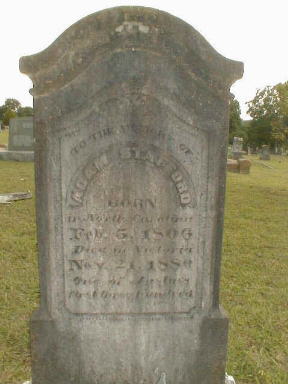
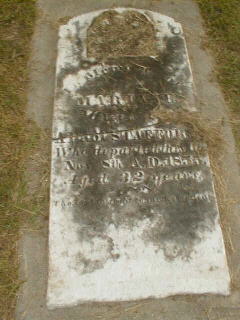
Adam Stafford
(1806-1880)
Adam Stafford, one of Stephen F. Austin's "Old 300" colonists, came to Texas to join his father William Stafford and received a labor of land in Waller County on Aug. 24, 1824. Single, Adam would settle into farming in Fort Bend County where his father had a cane mill and the first horse-powered cotton gin in the colony. Stafford was handicapped and couldn't fight during the Texas Revolution but helped by furnishing supplies to the Texas Army. In 1846, at the time of the Mexican War, he moved his family to Victoria where he became a breeder of fine horses. Considered somewhat eccentric in disposition, he was also considered warm hearted and kind - and, to his friends, was indeed a true friend. He died on Nov. 21, 1880, at the age of 74.

Victor Marion Rose
(1844-1893)
Victoria Marion Rose, historian, editor and poet, was born on Jan. 1, 1844, in Victoria, third of 12 children of Margaret Scott and John Washington Rose. In 1866, Rose married Julia Hardy, who after giving birth to a daughter died during the city's yellow fever epidemic of 1867. Rose himself almost succumbed. Rose was admitted to the bar in 1870 and was co-editor and publisher of the Victoria Advocate from 1869 to 1873. He moved to Laredo in the early 1880s, following a supposedly scandalous love affair, and became editor of the Laredo Times. He wrote a number of volumes of poetry and historical books, including Victor Rose's History of Victoria. Before his death of pneumonia on Feb. 5, 1893, he was editor of a newspaper in Myrtle Springs.
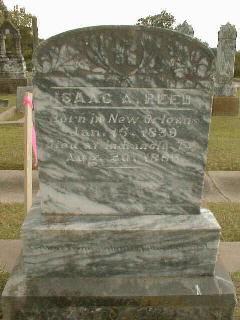
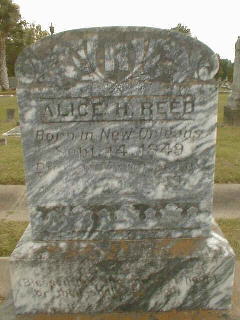
Isaac A. Reed
(1839-1886)
Born in New Orleans, Jan. 15, 1839, Isaac A. Reed was the Signal Service (weather station) observer at Indianola during the 1886 storm that was the final blow to the once flourishing port on Matagorda Bay. He was in the office with several others and was reluctant to leave his post as they began to vacate the building as the winds grew stronger and water deepened in the streets outside. He delayed his departure long enough to screw down the instruments measuring wind velocity, but failed to extinguish a kerosene lamp as he left. This would cause a fire that consumed much of the downtown area. Reed reached the sidewalk but was caught by falling timbers and drowned in waist deep water. It was August 20, 1886.
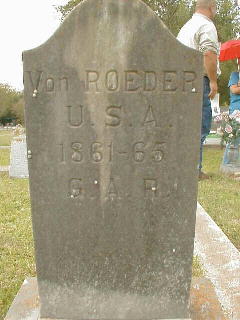
Von Roeder
(1837-1917)
While his small tombstone is simply inscribed "Von Roeder, USA 1861-1865 - G.A.R." in recognition of his service to the Grand Army of the Republic, his name might best be listed as George Otto H. Herold von Roedern, perhaps the only Yankee to be buried in a Confederate plot in Texas. Born March 20, 1837, in Trebnitz, Prussia, as Georg Otto Hoppe, he was serving in the Union army as Otto Hoppe when he came to Texas during the Civil War. He was at Gaines Mill, Manassas, Harper's Ferry and Lynchburg, among other places after joining the Union army in New York on March 11, 1862. He also served as a cavalry clerk at old Fort Concho, later lived for a time at Chappell Hill in Washington County, and taught music at Indianola from 1876 until the 1886 storm that finally destroyed the old seaport. He had lived for a time in England before coming to the United States. Considered something of a character during his later years, the "Professor" died in poverty on the streets of Victoria on Nov. 3, 1917. He was provided with a proper burial and final resting place by the William P. Rogers Chapter, United Daughters of the Confederacy, and the William R. Scurry Camp, United Confederate Veterans.


Gilbert Onderdonk
(1829-1920)
Gilbert Onderdonk, pioneer pomologist (the scientific study and cultivation of fruit) was born Sept. 30, 1829, to an old Dutch family at Sharon, New York. By age 11, he had already originated several new varieties of Irish potatoes and won 11 awards at the New York State Fair. He came to Texas in 1851 for his health and began teaching school and worked on a ranch at Green Lake. About 1858, he ventured into the nursery business, with an interruption for service during the Civil War in which he was taken captive and held prisoner in New Orleans. He returned to continue his nursery business at Mission Valley and later at Nursery, which he named and also served as postmaster. He introduced and developed numerous varieties of peaches, plums and other fruit and became a consultant to the U.S. Department of Agriculture. Onderdonk died on July 28, 1920.
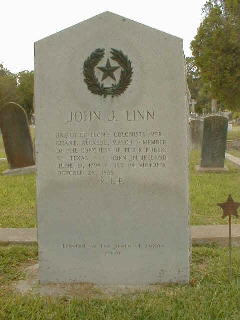
John Joseph Linn
(1798-1885)
There wasn't a lot to Don Martin de Leon's colony of Guadalupe Victoria when the merchant John Joseph Linn arrived in 1829. Born in Ireland on June 19, 1798, Linn had come to America as a little boy when his father was branded a traitor by British authorities. Apprenticed to a merchant in New York, he later established his own business in New Orleans. After becoming interested in doing business in Victoria, he established a wharf and warehouse on Lavaca Bay which came to be known as Linnville, the place that the Comanche Indians ransacked in 1840. Linn served both as the last alcalde and first mayor of Victoria. During the Texas Revolution, he was a quartermaster. His merchant ship would help to evacuate Harrisburg. He got to interview the defeated Mexican general Santa Anna and wrote dispatches for New Orleans newspapers. Twice he was arrested as a spy for Mexico, but was soon released. After independence, he served in the Congress of the Republic. His "Reminiscences of 50 Years in Texas" chronicles the early years of Victoria where he died on Oct. 28, 1885.

Margaret Wright
(1789-1879)
General Sam Houston once referred to her as "The Mother of Texas," no doubt in appreciation for what she had done in hiding and caring for some of the men who had escaped the massacre at Goliad. One of the early settlers of Victoria, Wright arrived as Marguerite Trudeau in 1826 with her two children. She had already outlived two husbands, James William Hays and Felix Trudeau. She settled just upriver on the Guadalupe and married John Wright. He is buried on the present Sterne place off the Lower Mission Valley Road. The Wrights had two children but the marriage was a difficult one and she believed that he had killed her son Peter Hays. They are said to have had the first contested divorce in Texas, it being litigated all the way to the Texas Supreme Court. Supposedly born to a French mother and English father in New Orleans in 1789 (1792?), Wright would die in poverty in Victoria on Oct. 21, 1878.
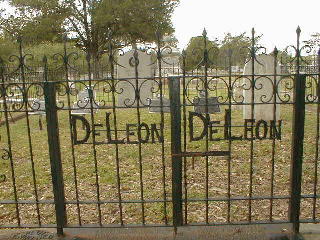
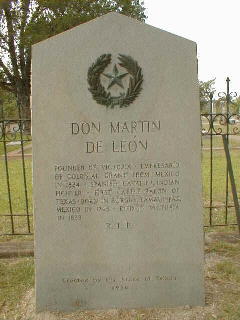
The DeLeon Family Plot
Don Martin de Leon was born in 1765 in Burgos, Nuevo Santander, known today as Tamaulipas. His parents Bernando and Maria Galvan DeLeon had come from Burgos, Spain. Don Martin became a merchant at an early age, joined up to fight the Indians in Nuevo Santander, and in 1795 married Patricia de la Garza, daughter of the commandant of the Eastern Internal Provinces. She would become a stalwart of Victoria in her own right. They started ranching in Nuevo Santander and after making a trip to Texas decided to settle, first on the Aransas River and then on the Guadalupe where he established Victoria in 1824 as a Mexican empresario. While this plot includes historical and other markers for De Leon, his wife and sons Fernando, Silvestre, Felix and Agapito, they are not all buried here, including De Leon himself. There has always been some question as just where he is buried. The family had a private cemetery at their home where the old Nazareth Academy is located on Church Street. It is uncertain what remains may have been removed to this site. Also, there are indications Fernando may have been buried in Memorial Square, the city's first public cemetery. There are also questions about Agapito being killed by Mustang Gray as noted on his historical marker.
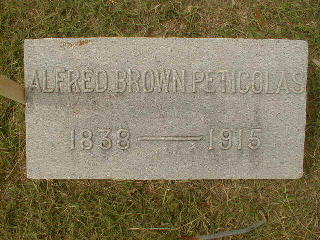
A.B. Peticolas
(1838-1915)
Alfred Brown Peticolas died on January 27, 1915, and was buried in this quiet spot. Born in Richmond, Virginia, on May 27, 1838, the fifth of 7 children, he taught school as a young man and studied law. He had begun his practice in Virginia when an uncle encouraged him to move west to Texas where he settled into a partnership with Samuel A. White. He is perhaps best remembered today for his Civil War journals and detailed pencil sketches, having served during the disastrous Sibley Campaign into New Mexico with Co. C., 4th Regiment, Texas Mounted Volunteers. He later served as a quartermaster sergeant in the Louisiana campaign. After his discharge in Houston on May 23, 1865, he returned to Victoria to again practice law. He also served as editor of the Victoria Advocate from 1881 to 1888 and wrote a law book that was a standard text of the Texas Bar Association for many years. Tall and impressive, Peticolas was known as the "Judge." He liked to sketch local scenes, travel in Europe, play chess, and handcraft furniture.

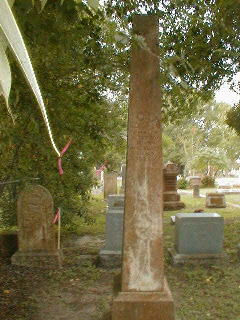
Bill and Laura Sutton
On the 11th of March, 1874, with their friend, young Gabriel Slaughter, Bill and Laura Sutton were buying tickets at Indianola to board the steamer "Clinton" for Galveston, when out of nowhere James and Bill Taylor starting shooting. This was one of many incidents of the longstanding Taylor-Sutton Feud, a result of the turbulent times of Reconstruction. Twenty years old and pregnant at the time, Laura watched her 17-year-old husband being shot in the back with two six-shooters. Mrs. John N. Keeran rushed up to help and held Bill's head as he lay dying. Both Sutton and Slaughter are buried here along the fence. Gabriel had tried to warn his friend, saying that they had better get their guns, but Sutton didn't think the Taylors would do anything in such a public place. The story of the feud is too lengthy to detail here, but Laura went on to give birth to her and Bill's daughter, naming her William Slaughter Sutton. Willie or "Girlie" as she was sometimes called, married J.W. Calhoun and died at the young age of 34 on March 24, 1908. Laura died in 1930 at the age of 77, all being buried here. Jim Taylor would die in a gunfight at Clinton during Christmas Week, 1875, as the feud continued, while Bill Taylor was eventually acquitted and left the area.
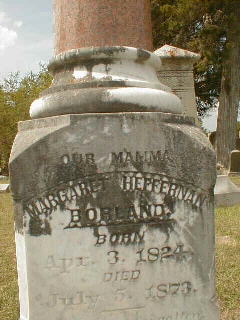
Margaret Heffernan Borland
(1824-1873)
Margaret Heffernan was born April 3, 1824, her father, John Heffernan, being among the Irish who settled San Patricio. She married Harrison Dunbar, who was killed in a quarrel in Victoria, then married Milton Hardy several years later and he died of cholera in 1855. She next married Alexander Borland who died in 1867 along with three of her daughters and a son during a yellow fever epidemic. One of the daughters was Julia Hardy, who married historian Victoria Rose, another being Mary Dunbar, wife of A.B. Peticolas. Margaret had assisted Borland with his cattle business prior to his death and afterwards assumed full responsibility with more than 10,000 cattle under her management in the early 1870s. Perhaps the only woman to ever take a herd up the Chisholm Trail under her own direction, she left in the spring of 1873 with two sons under 15 years of age, a 7-year-old daughter and even younger granddaughter, 4-year-old Julia Rosa Rose. With a good group of trail hands, she herded 2,500 cattle to Wichita, Kansas, where she came down with "trail fever" and died on July 5 after which her body was returned to Victoria for burial.

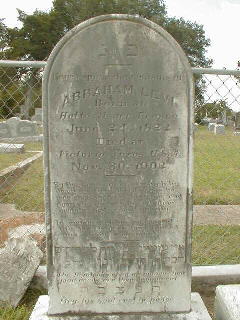
Abraham Levi
(1822-1902)
This is the old Jewish section of Evergreen Cemetery and this is the grave of Abraham Levi, born June 24, 1822, in Alsace, where as a boy of 13 he roamed the countryside peddling ribbons and baubles. In 1846, he boarded a boat for New Orleans. He moved up the Mississippi and worked as a butcher and as a peddler until taking a job with the merchant A. Schwartz at Liberty, Mississippi. With a loan from Scwartz's brother-in-law Jacob Halfin, the young Levi and Halfin's brother Henry headed for Texas and Victoria in 1849 to open a store in the Globe House Hotel. He married Halfin's sister Mina the same year. By 1861, Levi was involved in the largest dry goods establishment in Southwest Texas. After a fire and dissolving the partnership, Levi returned to France toward the end of the Civil War, then went to Mexico, but returned in 1866 to Victoria to open a wholesale grocery business and formed a partnership with a cousin, Henry Levi. They got into the banking business under the name A. Levi & Co., Bankers, the beginnings of Victoria Bank & Trust Co., now owned by Wells Fargo. He was active in local politics, other business ventures, and the Jewish congregation B'nai B'rith. He died on Nov. 30, 1902.

